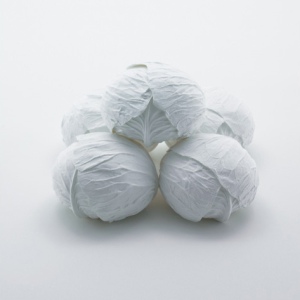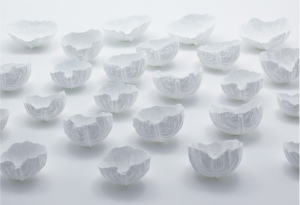The use of Metaphor is for many designers a strategy for poetic imagination. It is used to create visual magic in a meaningful manner, which can aid to alter or re-design an object into a masterpiece.Audience align their mental ideas of the world and are able to sense a deeper connection with the information shared with them heightening their understanding.
This can be shown through Japanese designer Yasuhiro Suzuki who graduated from Tokyo Zokei university. His works focus on using unexpected everyday discovery which sensitizes us. In his piece ‘Cabbage bowls‘ he metaphorically redesigns the convectional paper bowl through likening them to cabbage leaves , peeling away the mundane ‘everyday’ object into a new more valuable creation.The bowl is created directly from a real cabbage. A mold is made in white paper clay on the leaves and once dry it is peeled off leaving an identical imprint. Each leaf becomes a ‘dish’ and when restacked makes a head of the cabbage again. This sensitivity and detail to both the design and functionality is what alters it into an object of more value.
 In ‘ cabbage bowls’ the multiple layers of similarly between the cabbage and the bowl allows for a cleaver connection in producing an innovative design. Much like the paper bowl is able to contain and store the curved bowl shape of a cabbage leaf also reflets this idea. Through using a thicker material , it allows for more permanence than a cabbage leaf. As the object is still designed to be disposable, one may be less inclined to ‘waste’ due to the added value and embedded beauty. So Something which still functions the same as paper bowls, is escalated to hold more worth due to the intricacy of its beauty. Another metaphorical layer between the cabbage bowl and paper bowls is the use of ‘stacking’. Much like paper plates are able to stack into a single unit and snap off when needed, Suzuki’s cabbage bowls too are able to be stacked into a single unit, with each leaf to be peeled or ‘snapped off’ when needed. Through this Suzuki reflects how Metaphors can be used in designs as a strategy for poetic magic and innovation. Users are able to sense a deeper connection with their world and have a more sensitized experience. Furthermore the use of white aids in creating a muted, not overly extreme piece, to create a feeling of peacefulness drawing a response forms the viewer. Kenya Hara stated in ‘ Design boom’ on viewing Cabbage bowls that ‘white’ is not solely a color but a design concept. “… We cannot look for white; we need to search instead for a way of feeling that will sense white. We will become able to understand words like ‘tranquility,’ or ‘emptiness,’ and discern the meanings dormant within them.
” Through this we can see how the colour ‘white’ can allow viewers to further re-evaluate and seek for a deeper connection with the meaning of the work. Each person might view the object in a different way according to their own experiences and perceptions. Other notions of white include purity and innocence. In the image below this idea is shown. The use of white on white in hand with the positioning of the leaves creates them to appear ‘holy’ ‘pure’ and in a spiritual state. This reflect the pureness of form and how the shape of the leaf was left ‘untouched’
In ‘ cabbage bowls’ the multiple layers of similarly between the cabbage and the bowl allows for a cleaver connection in producing an innovative design. Much like the paper bowl is able to contain and store the curved bowl shape of a cabbage leaf also reflets this idea. Through using a thicker material , it allows for more permanence than a cabbage leaf. As the object is still designed to be disposable, one may be less inclined to ‘waste’ due to the added value and embedded beauty. So Something which still functions the same as paper bowls, is escalated to hold more worth due to the intricacy of its beauty. Another metaphorical layer between the cabbage bowl and paper bowls is the use of ‘stacking’. Much like paper plates are able to stack into a single unit and snap off when needed, Suzuki’s cabbage bowls too are able to be stacked into a single unit, with each leaf to be peeled or ‘snapped off’ when needed. Through this Suzuki reflects how Metaphors can be used in designs as a strategy for poetic magic and innovation. Users are able to sense a deeper connection with their world and have a more sensitized experience. Furthermore the use of white aids in creating a muted, not overly extreme piece, to create a feeling of peacefulness drawing a response forms the viewer. Kenya Hara stated in ‘ Design boom’ on viewing Cabbage bowls that ‘white’ is not solely a color but a design concept. “… We cannot look for white; we need to search instead for a way of feeling that will sense white. We will become able to understand words like ‘tranquility,’ or ‘emptiness,’ and discern the meanings dormant within them.
” Through this we can see how the colour ‘white’ can allow viewers to further re-evaluate and seek for a deeper connection with the meaning of the work. Each person might view the object in a different way according to their own experiences and perceptions. Other notions of white include purity and innocence. In the image below this idea is shown. The use of white on white in hand with the positioning of the leaves creates them to appear ‘holy’ ‘pure’ and in a spiritual state. This reflect the pureness of form and how the shape of the leaf was left ‘untouched’  In contrast this work may appear sterile and empty. The open structure of the cabbage reflect its ’emptiness’ and perhaps leaves it up to the viewer to fill it with meaning, sensitising the users experience. Further reading Unfolded: Paper in Design, Art, Architecture and Industry By Petra Schmidt, Nicola Stattmann Blinking And Flapping – Yasuhiro Suzuki
In contrast this work may appear sterile and empty. The open structure of the cabbage reflect its ’emptiness’ and perhaps leaves it up to the viewer to fill it with meaning, sensitising the users experience. Further reading Unfolded: Paper in Design, Art, Architecture and Industry By Petra Schmidt, Nicola Stattmann Blinking And Flapping – Yasuhiro Suzuki
You must be logged in to post a comment.